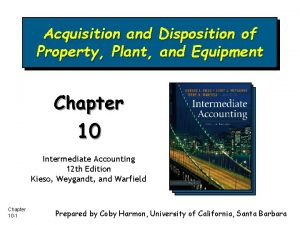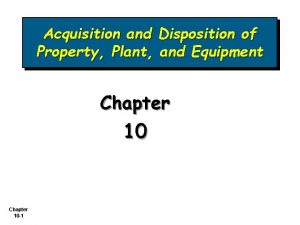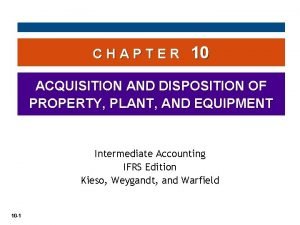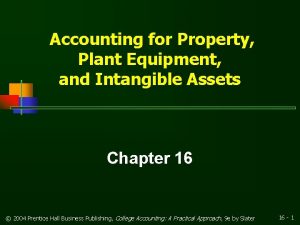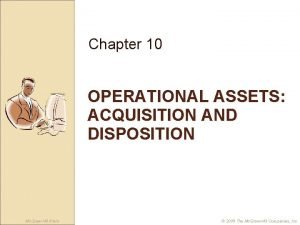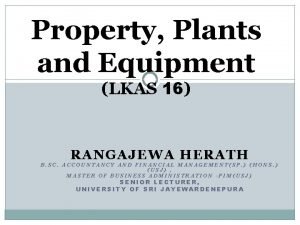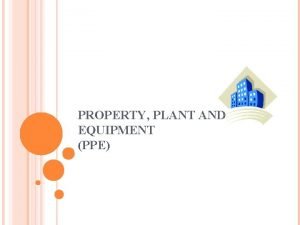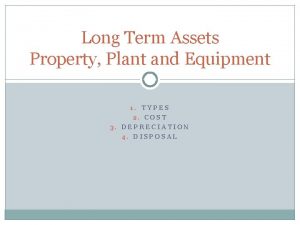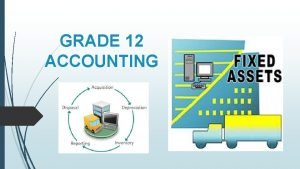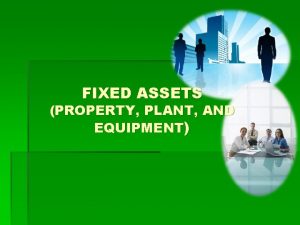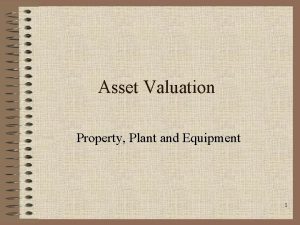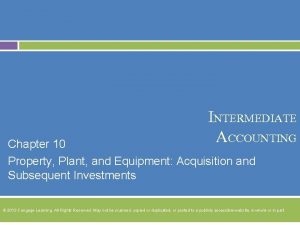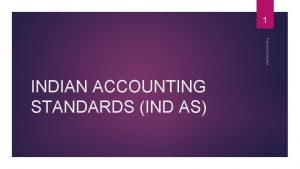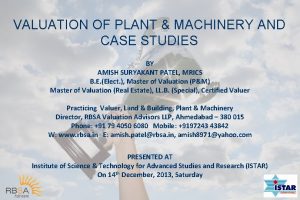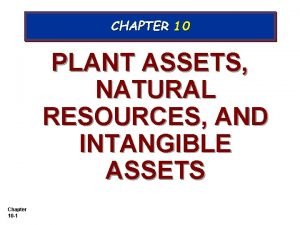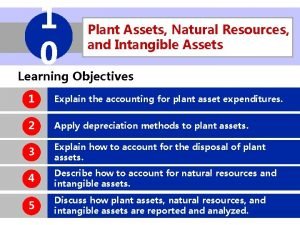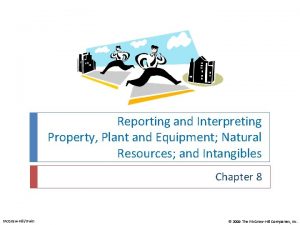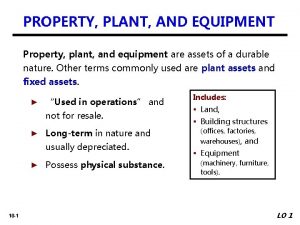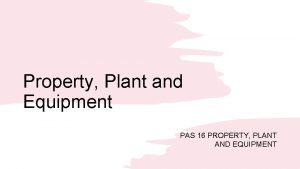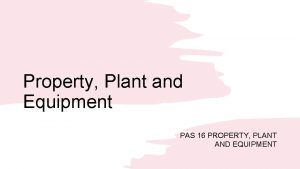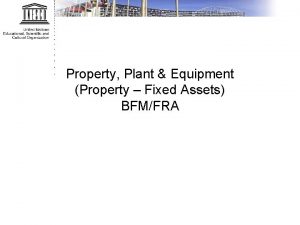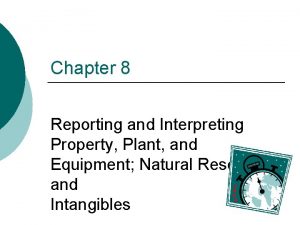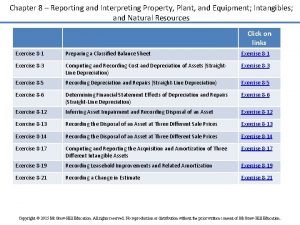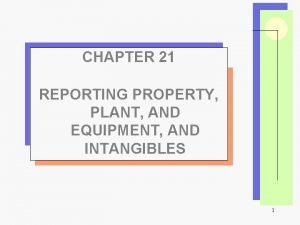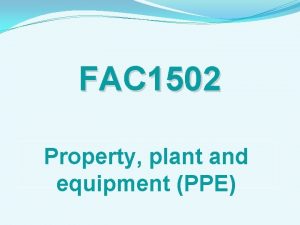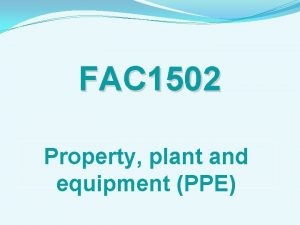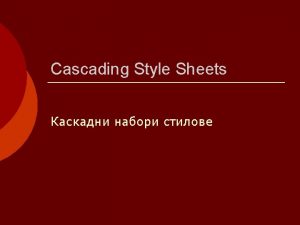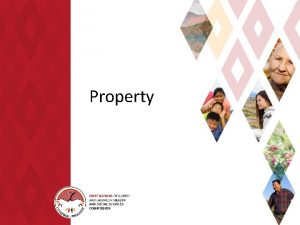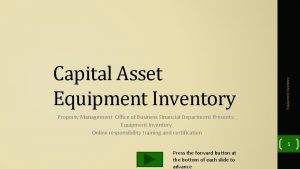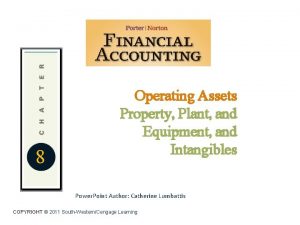Reporting and Interpreting Property Plant and Equipment Natural



























- Slides: 27

Reporting and Interpreting Property, Plant and Equipment; Natural Resources; and Intangibles Chapter 8 Mc. Graw-Hill/Irwin © 2009 The Mc. Graw-Hill Companies, Inc.

Classifying Long-Lived Assets Actively Used in Operations Examples Value represented by rights that produce benefits n Land Examples Expected to Benefit Future Periods n Assets subject to depreciation • Definite life q Buildings and equipment Patents q Furniture and fixtures Copyrights Intangible n Natural resource assets Tangible Franchises subject to depletion • Physical Indefinite life No Physical q Mineral deposits and timber Trademarks Substance Goodwill Mc. Graw-Hill/Irwin Slide 2

Measuring and Recording Acquisition Cost Acquisition cost includes the purchase price and all expenditures needed to prepare the asset for its intended use. Acquisition cost does not include financing charges and cash discounts. Mc. Graw-Hill/Irwin Slide 3

Depreciation Concepts Depreciation is a cost allocation process that systematically and rationally matches acquisition costs of operational assets with periods benefited by their use. Balance Sheet Acquisition Cost (Unused) Income Statement Cost Expense Allocation (Used) Depreciation Expense Depreciation for the current year Income Statement Accumulated Depreciation Total of depreciation to date on an asset Balance Sheet Mc. Graw-Hill/Irwin Slide 4

Depreciation Concepts The calculation of depreciation requires three amounts for each asset: Acquisition cost. Estimated useful life. Estimated residual value. Alternative depreciation methods: Straight-line Units-of-production Accelerated Method: Declining balance Mc. Graw-Hill/Irwin Slide 5

Straight-Line Method Depreciation Expense per Year = Cost - Residual Value Life in Years At the beginning of the year, Southwest purchased ground equipment for $62, 500 cash. The equipment has an estimated useful life of 3 years and an estimated residual value of $2, 500. Depreciation Expense per Year = Mc. Graw-Hill/Irwin $62, 500 - $2, 500 3 years $20, 000 Slide 6

Straight-Line Method Residual Value SL Mc. Graw-Hill/Irwin More companies use the straight-line method of depreciation in their financial reports than all other methods combined. Slide 7

Units-of-Production Method Step 1: Depreciation = Rate Cost - Residual Value Life in Units of Production Step 2: Number of Depreciation × Units Produced = Expense Rate for the Year At the beginning of the year, Southwest purchased ground equipment for $62, 500 cash. The equipment has a 100, 000 mile useful life and an estimated residual value of $2, 500. If the equipment is used 30, 000 miles in the first year, what is the amount of depreciation expense? Mc. Graw-Hill/Irwin Slide 8

Units-of-Production Method Step 1: Depreciation = $62, 500 - $2, 500 = $. 60 per mile 100, 000 miles Rate Step 2: Depreciation = $. 60 per mile × 30, 000 miles = $18, 000 Expense Mc. Graw-Hill/Irwin Residual Value Slide 9

Accelerated Depreciation Accelerated depreciation matches higher depreciation expense with higher revenues in the early years of an asset’s useful life when the asset is more efficient. Depreciation Expense Early Years High Later Years Mc. Graw-Hill/Irwin Low Repair Expense Low High Slide 10

Declining-Balance Method Declining balance rate of 2 is double-decliningbalance (DDB) rate. Cost – Accumulated Depreciation Annual Depreciation = expense Net Book Value × ( 2 Useful Life in Years ) Annual computation ignores residual value. At the beginning of the year, Southwest purchased equipment for $62, 500 cash. The equipment has an estimated useful life of 3 years and an estimated residual value of $2, 500. Calculate the depreciation expense for the first two years. Mc. Graw-Hill/Irwin Slide 11

Declining-Balance Method Annual Depreciation expense Net Book Value = Year 1 Depreciation: $62, 500 × ( × 2 3 years ( Mc. Graw-Hill/Irwin ) ) = $41, 667 Year 2 Depreciation: ($62, 500 – $41, 667) × 2 Useful Life in Years ( 2 3 years ) = $13, 889 Slide 12

Declining-Balance Method Below residual value ($62, 500 – $55, 556) × Mc. Graw-Hill/Irwin ( 2 3 years ) = $4, 629 Slide 13

Declining-Balance Method Depreciation expense is limited to the amount that reduces book value to the estimated residual value. Mc. Graw-Hill/Irwin Slide 14

Repairs, Maintenance, and Additions Mc. Graw-Hill/Irwin Slide 15

Repairs, Maintenance, and Additions To solve this problem, many companies have policies regarding the expensing of all expenditures below a certain amount according to the materiality constraint. Mc. Graw-Hill/Irwin Slide 16

Disposal of Property, Plant, and Equipment Update depreciation to the date of disposal. Journalize disposal by: Recording cash received (debit) or paid (credit). Recording a gain (credit) or loss (debit). Writing off accumulated depreciation (debit). Writing off the asset cost (credit). Mc. Graw-Hill/Irwin Slide 17

Disposal of Property, Plant, and Equipment If Cash > BV, record a gain (credit). If Cash < BV, record a loss (debit). If Cash = BV, no gain or loss. Southwest Airlines sold flight equipment for $5, 000 cash at the end of its 17 th year of use. The flight equipment originally cost $20, 000, and was depreciated using the straight-line method with zero residual value and a useful life of 20 years. Mc. Graw-Hill/Irwin Slide 18

Disposal of Property, Plant, and Equipment Prepare the journal entry to record Southwest’s sale of the equipment at the end of the 17 th year. Mc. Graw-Hill/Irwin Slide 19

Fixed Asset Turnover Fixed = Asset Turnover Net Sales Revenue Average Net Fixed Assets This ratio measures a company’s ability to generate sales given an investment in fixed assets. During 2009, Southwest Airlines had $10, 350 of revenue. Endof-year fixed assets were $10, 634 and beginning-of-year fixed assets were $11, 040. (All numbers in millions. ) Fixed = Asset Turnover Mc. Graw-Hill/Irwin $10, 350 ($10, 634 + $11, 040) ÷ 2 = 0. 96 Slide 20

Acquisition and Depletion of Natural Resources Extracted from the natural environment. A noncurrent asset presented at cost less accumulated depletion. Total cost of asset is the cost of acquisition, exploration, and development. Total cost is allocated over periods benefited by means of depletion. Examples: oil, coal, gold Depletion is like units-of-production depreciation. Mc. Graw-Hill/Irwin Slide 21

Acquisition and Depletion of Natural Resources The unit depletion rate is calculated as follows: Acquisition and Development Cost – Residual Value Estimated Recoverable Units Depletion cost for a period is: UNIT DEPLETION RATE Depletion cost Mc. Graw-Hill/Irwin × NUMBER OF UNITS EXTRACTED IN PERIOD Inventory for sale Cost of goods sold Unsold Inventory Slide 22

Acquisition and Amortization of Intangible Assets Noncurrent assets without physical substance. Useful life is often difficult to determine. Intangible Assets: -Patents -Trademarks -Copyrights -Franchises -Licenses Often provide exclusive rights or privileges. Usually acquired for operational use. Record at current cash equivalent cost, including purchase price, legal fees, and filing fees. Mc. Graw-Hill/Irwin Slide 23

Acquisition and Amortization of Intangible Assets Goodwill Occurs when one company buys another company. Only purchased goodwill is an intangible asset. The amount by which the purchase price exceeds the fair market value of net assets acquired. Goodwill is not amortized. Its value must be reviewed at least annually for possible impairment, and the book value is reduced to fair value if impaired. Mc. Graw-Hill/Irwin Slide 24

Acquisition and Amortization of Intangible Assets Definite Life • Amortize over shorter of economic life or legal life, subject to rules specified by GAAP. • Use straight-line method. Indefinite Life • Not amortized. • Tested at least annually for possible impairment, and book value is reduced to fair value if impaired. Amortization is a cost allocation process similar to depreciation and depletion. Mc. Graw-Hill/Irwin Slide 25

Measuring Asset Impairment is the loss of a significant portion of the utility of an asset through. . . • Casualty. • Obsolescence. • Lack of demand for the asset’s services. Recognize a loss when an asset suffers a permanent impairment. Determination of Asset Impairment Compare Net Book Value to Estimated Future Cash Flows: • If FCF>NBV, do nothing • If FCF<NBV, asset is impaired Record Impairment: • Asset Impairment Loss XXX • Asset XXX • XXX=Difference between NBV and Fair (Market) Value Mc. Graw-Hill/Irwin Slide 26

End of Chapter 8 © 2008 The Mc. Graw-Hill Companies, Inc.
 Acquisition and disposition of property plant and equipment
Acquisition and disposition of property plant and equipment Acquisition and disposition of property plant and equipment
Acquisition and disposition of property plant and equipment Acquisition and disposition of property plant and equipment
Acquisition and disposition of property plant and equipment Property, plant, and equipment and intangible assets are
Property, plant, and equipment and intangible assets are Acquisition and disposition of property plant and equipment
Acquisition and disposition of property plant and equipment Lkas16
Lkas16 Useful life of property plant and equipment
Useful life of property plant and equipment Plant assets are used in operations
Plant assets are used in operations Fixed asset note
Fixed asset note Useful life of property plant and equipment
Useful life of property plant and equipment Property plant and equipment
Property plant and equipment Intermediate accounting chapter 10
Intermediate accounting chapter 10 Ind as 16 property plant and equipment
Ind as 16 property plant and equipment Missouri unclaimed property over $50
Missouri unclaimed property over $50 Sapratibandha
Sapratibandha Chemical properties of citric acid
Chemical properties of citric acid Plant and machinery valuation case study
Plant and machinery valuation case study Commutative vs associative
Commutative vs associative Tronsmo plant pathology and plant diseases download
Tronsmo plant pathology and plant diseases download Tronsmo plant pathology and plant diseases download
Tronsmo plant pathology and plant diseases download Tronsmo plant pathology and plant diseases download
Tronsmo plant pathology and plant diseases download Depreciation expense formula
Depreciation expense formula Accumulated depreciation straight line method
Accumulated depreciation straight line method Plant assets, natural resources, and intangible assets
Plant assets, natural resources, and intangible assets Natural capital and natural income
Natural capital and natural income Sem vi
Sem vi Plant breeding for disease resistance
Plant breeding for disease resistance Plant introduction in plant breeding
Plant introduction in plant breeding
